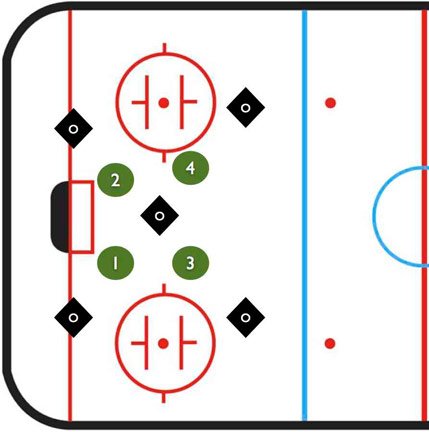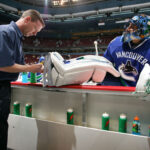A penalty kill in hockey is when a team plays with fewer players due to a penalty. The objective is to prevent the opposing team from scoring.
In hockey, penalties can drastically change the dynamics of the game. A penalty kill occurs when a team is short-handed because one or more players are serving time in the penalty box. During this period, the penalized team focuses on strong defensive strategies to prevent the opposing team, which has a numerical advantage, from scoring.
Effective penalty killing requires excellent teamwork, positioning, and goaltending. Teams often deploy their best defensive players to manage this challenging situation. Penalty kills are crucial moments that can significantly impact the outcome of a game, highlighting the importance of discipline and strategic play in hockey.
Introduction To Penalty Kill
In hockey, a penalty kill is a key strategy. Teams use it to defend when short-handed. Understanding it helps fans enjoy the game more.
Basic Concept
A penalty kill happens when a team has fewer players on the ice. This usually occurs due to a penalty. The opposing team then has a power play advantage.
- The team with fewer players is on the penalty kill.
- The other team tries to score with more players.
The penalty kill team must defend well. They focus on stopping the opposing team from scoring.
Importance In Hockey
Penalty killing is crucial in hockey. It can change the game’s outcome. A strong penalty kill can boost team morale.
| Aspect | Importance |
|---|---|
| Defense | Stops goals during power plays |
| Morale | Boosts team confidence |
| Strategy | Shows team’s tactical skills |
Teams with good penalty kill units often succeed. It shows their defensive strength and teamwork.

Credit: www.youtube.com
Key Objectives
The penalty kill is crucial in hockey. Teams must defend against a power play. The key objectives focus on preventing goals and disrupting power plays.
Preventing Goals
A team’s main goal during a penalty kill is to stop goals. They play defensively to protect their net. Players work together to block shots. They also clear the puck from their zone. This makes it hard for the opposing team to score.
- Block Shots: Players use their bodies to stop the puck.
- Clear the Puck: They send it down the ice to waste time.
- Protect the Net: The goalie and defense guard the goal closely.
Disrupting Power Plays
Disrupting the power play is another key objective. Teams use tactics to break the opposing team’s strategy. They force turnovers and make it hard to set up plays.
- Pressure the Puck: Players chase the puck carrier aggressively.
- Force Turnovers: They create chances to steal the puck.
- Interrupt Passes: They block passing lanes with their sticks and bodies.
| Objective | Actions |
|---|---|
| Prevent Goals | Block shots, clear the puck, protect the net |
| Disrupt Power Plays | Pressure the puck, force turnovers, interrupt passes |
Penalty Kill Formations
Penalty kill formations are essential strategies in hockey. They help teams defend against power plays. By using specific formations, teams can minimize scoring chances. Two popular formations are the Box Formation and the Diamond Formation.
Box Formation
The Box Formation is a common penalty kill strategy. It involves four players forming a square. This shape covers the area in front of the net. Each player has a specific zone to defend.
Here is how it works:
- Two defenders stay near the goalposts.
- Two forwards stay near the top of the circle.
- The players move together as a unit.
The Box Formation aims to block shots and passes. It forces the attacking team to take low-percentage shots. It also makes it harder for attackers to get close to the net.
Diamond Formation
The Diamond Formation is another effective penalty kill strategy. This formation is shaped like a diamond, with one player at each point. It is used to pressure the puck carrier and block passing lanes.
Here is how it works:
- One player stands at the top of the slot.
- Two players cover the sides, near the hash marks.
- One player stays near the net.
The Diamond Formation aims to create turnovers. It forces the attacking team to make quick decisions. This formation can also lead to short-handed scoring opportunities.
Both the Box and Diamond formations are crucial for a successful penalty kill. Teams choose the formation based on the situation and opponent’s strengths.
Effective Strategies
Understanding effective strategies for a penalty kill in hockey can make a huge difference. These strategies can help a team defend against power plays and keep the opposing team from scoring. Let’s dive into two key strategies: aggressive forechecking and the passive box.
Aggressive Forechecking
Aggressive forechecking is a bold and proactive strategy. It involves players pressuring the puck carrier in the offensive zone. The goal is to force turnovers and disrupt the opponent’s attack.
- High Pressure: Players apply intense pressure on the puck carrier.
- Quick Transitions: Defensemen quickly transition to offense after gaining control.
- Forcing Errors: Aggressive play forces the opponent to make mistakes.
This strategy requires speed, coordination, and stamina. Players must be quick and smart to execute it well. It can be risky but effective if done correctly.
Passive Box
The passive box is a more conservative strategy. It involves forming a tight, square formation to protect the goal area. The main aim is to block shooting lanes and passes.
- Formation: Players form a tight box around the goal.
- Blocking Shots: Focus on blocking shots and passes.
- Maintaining Position: Players stay in position and don’t chase the puck.
This strategy emphasizes patience and positioning. Players must maintain their formation and avoid getting drawn out of position. It’s less risky and can be very effective in neutralizing power plays.
| Strategy | Key Features | Advantages |
|---|---|---|
| Aggressive Forechecking | High pressure, quick transitions, forcing errors | Disrupts opponents, creates turnovers |
| Passive Box | Formation, blocking shots, maintaining position | Protects goal, minimizes risk |
Role Of Players
In hockey, the penalty kill is a critical phase. During this time, the defending team is short one player. The remaining players must work together to prevent the opposing team from scoring. The roles of the players during a penalty kill are very specific. Each player has unique responsibilities that contribute to the team’s success.
Defensemen Responsibilities
Defensemen play a key role during a penalty kill. They must protect the goal at all costs. Here are their primary responsibilities:
- Block shots from the opposing team.
- Clear the puck from the defensive zone.
- Maintain strong positioning near the goal.
- Communicate with the goalie and other players.
Defensemen must stay alert and anticipate the opponent’s moves. They need to be quick and decisive in their actions.
Forward Responsibilities
Forwards also have vital duties during a penalty kill. Their main goal is to disrupt the opposing team’s offense. Here are their key tasks:
- Apply pressure to the puck carrier.
- Force turnovers and gain control of the puck.
- Support defensemen by covering open players.
- Attempt to clear the puck from the defensive zone.
Forwards must use their speed and agility to interrupt passing lanes. They should work together to create opportunities for a counter-attack.
Communication And Coordination
In hockey, the penalty kill is a critical defensive strategy. Teams play short-handed due to penalties. Success depends on communication and coordination. These elements ensure players stay in sync.
Importance Of Teamwork
Teamwork is crucial during a penalty kill. Each player must understand their role. They need to cover the ice effectively. This prevents the other team from scoring.
Players must trust each other. They rely on their teammates to cover gaps. This collective effort helps maintain a solid defense.
| Role | Responsibility |
|---|---|
| Forwards | Pressure the puck carrier |
| Defensemen | Protect the goal area |
| Goalie | Make crucial saves |
Effective Signaling
Effective signaling is vital for success. Players use hand signals and verbal cues. These signals help communicate quickly and clearly.
- Hand signals: Indicate play direction
- Verbal cues: Alert teammates to danger
Signaling keeps everyone on the same page. Quick reactions are essential. A well-coordinated team can thwart power plays.
Overall, communication and coordination are key. They ensure a successful penalty kill. Teams must practice these skills regularly.
Common Mistakes
Understanding the common mistakes in a penalty kill can improve a team’s defense. Here are some frequent errors and how to avoid them.
Overcommitting
Overcommitting happens when players chase the puck too aggressively. This leaves gaps in the defense. Opponents can then exploit these gaps.
Here are key points to remember:
- Stay in your zone: Don’t leave your assigned area.
- Watch the puck: Keep your eyes on the puck, but don’t chase it.
- Communicate: Talk to your teammates to ensure coverage.
Poor Positioning
Poor positioning means players are not in the right place. This can lead to easy scoring chances for the opposition.
To improve positioning:
- Know your role: Understand your position and responsibilities.
- Stay between the puck and the goal: Always block the direct path to the net.
- Be aware of opponents: Keep track of opposing players around you.
Here is a simple table to remember positioning tips:
| Tip | Description |
|---|---|
| Stay in your zone | Don’t chase the puck out of your area. |
| Block the path | Position yourself between the puck and the goal. |
| Track opponents | Always know where the opposing players are. |

Credit: m.youtube.com
Training And Drills
Effective penalty killing requires rigorous training and specialized drills. Hockey teams use these to sharpen their defensive skills and improve their coordination. Training and drills focus on various aspects such as positioning, communication, and quick decision-making. Below, we dive into some essential drills and techniques.
Drill Examples
Penalty kill drills help players practice defending against power plays. Here are a few examples:
- Box Formation Drill: Four players form a box shape. They move in unison to block passing lanes.
- Pressure Points Drill: Players practice pressuring the puck carrier. This forces mistakes and turnovers.
- Shot Blocking Drill: Players learn to block shots effectively. They practice positioning themselves in the shooting lane.
- Clear the Zone Drill: This drill focuses on clearing the puck from the defensive zone. Players practice using the boards and glass.
Improving Reaction Time
Reaction time is crucial for a successful penalty kill. Quick reactions can disrupt the opponent’s play. Here are some drills to improve reaction time:
- Quick Pass Drill: Players pass the puck quickly among themselves. They must react and move swiftly.
- Mirror Drill: One player mirrors the movements of another. This helps in improving defensive agility.
- Rapid Shot Drill: Players face rapid-fire shots from different angles. This enhances their ability to react and block shots.
- Agility Ladder Drill: Using an agility ladder, players perform quick footwork exercises. This improves their speed and coordination.
| Drill | Focus Area |
|---|---|
| Box Formation Drill | Blocking passing lanes |
| Pressure Points Drill | Pressuring puck carrier |
| Shot Blocking Drill | Blocking shots |
| Clear the Zone Drill | Clearing the puck |
| Quick Pass Drill | Quick reactions and passing |
| Mirror Drill | Defensive agility |
| Rapid Shot Drill | Shot blocking reactions |
| Agility Ladder Drill | Speed and coordination |

Credit: blog.purehockey.com
Frequently Asked Questions
What Does Killing A Penalty Mean In Hockey?
Killing a penalty in hockey means successfully preventing the opposing team from scoring during a power play.
What Is The Rarest Penalty In Hockey?
The rarest penalty in hockey is the “gross misconduct” penalty. It results from severe unsportsmanlike behavior.
What Is Penalty Kill In Hockey Reddit?
A penalty kill in hockey is when a team plays with fewer players due to a penalty. The team must defend against the opposing team’s power play.
What Is Penalty Shoot In Hockey?
A penalty shoot in hockey is a one-on-one contest between a shooter and the goalie. The shooter tries to score, while the goalie aims to block the shot. This occurs after regular play ends in a tie or to penalize a specific foul.
It adds excitement and determines the winner.
Conclusion
Mastering the penalty kill is crucial for any hockey team. It requires strategy, teamwork, and constant practice. Fans appreciate the skill and determination shown during these intense moments. Understanding this aspect of hockey enhances your enjoyment of the game. Follow your favorite team and see how they handle penalty kills.


